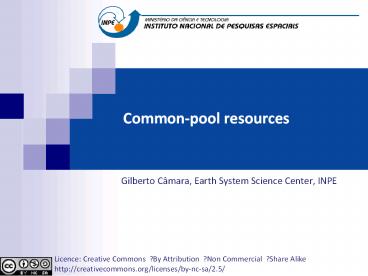Common-pool resources - PowerPoint PPT Presentation
Title:
Common-pool resources
Description:
Title: Introduction to Spatial Dynamical Modelling Author: Gilberto Camara Last modified by: Gilberto Camara Created Date: 8/23/2006 8:15:58 PM Document presentation ... – PowerPoint PPT presentation
Number of Views:81
Avg rating:3.0/5.0
Title: Common-pool resources
1
Common-pool resources
- Gilberto Câmara, Earth System Science Center, INPE
Licence Creative Commons ???? By Attribution
???? Non Commercial ???? Share
Alike http//creativecommons.org/licenses/by-nc-sa
/2.5/
2
Acknowledgments for using previous material
- Martin Nowak (Harvard University, USA)
- Francisco C. Santos (Université Libre de
Bruxelles, Belgium) - Craig Callender (Philosophy, Univ California San
Diego, USA) - Ana Aguiar (INPE, Brazil)
- Tiago Carneiro (Federal University of Ouro Preto,
Brazil) - Guy Brasseur (NCAR, USA)
3
What cooperation can achieve...
Those were the days
http//www.youtube.com/watch?v0HrjevD2vhkfeature
related
4
Collective spatial action volunteered GI
Are Brazilians less cooperative? Less tech-savvy?
Does google solve their problems? Are they happy
with their public data?
5
Collective spatial action pedestrian modelling
Notting Hill Carnival (London)
Batty, Agent-Based Pedestrian Modelling, in
Advanced Spatial Analysis, ESRI Press, 2003.
6
Collective spatial action deforestation
7
Collective spatial action global change
9.9 PgC
12 of total
Le Quéré et al. 2009, Nature-geoscience, 2009
8
An explicit spatial problem in global change
land change
Land-change science has emerged as a
foundational element of global environment change
and sustainability science (Rindfuss et al,
Developing a science of land change, PNAS,
2004).
9
source Global Land Project Science Plan (IGBP)
10
Impacts of global land change
More vulnerable communities are those most at risk
11
We need spatially explicit models to understand
human-environment interactions
Nature Physical equations Describe processes
Society Decisions on how to Use Earths
resources
12
Modelling collective spatial actions the complex
systems approach
photo Chico Albuquerque
- Situated individuals (persons, groups, agents)
- Interaction rules - communication
- Decision rules - actions
- Properties of space
13
Our spatially explicit models need good social
theories to guide them
Nature Physical equations Describe processes
Society Decisions on how to Use Earths
resources
14
We need social theories to understand
human-environment interactions
- Survey
- Moran, Environmental Social Science
Human-Environment Interactions and
Sustainability (2010) - Social simulation
- Schelling, Micromotives and macrobehavior
(1978). - Batty, Cities and complexity (2005).
- Game theory
- von Neumann and Morgenstern, Theory of games and
economic behavior (1944) - Nash, "Equilibrium points in n-person games
(1950). - Evolutionary dynamics
- Maynard Smith, Evolution and the theory of
games (1982) - Axelrod, Evolution of cooperation (1988).
- Novak, Evolutionary dynamics exploring the
equations of life (2005). - Institutional analysis
- Ostrom, Governing the commons (1990).
15
Common pool resources (Elinor Ostrom)
16
The ultimate common pool resource
17
Governing the commons
Ostrom, Science, 2005
18
Governing the commons Ostroms conditions
- Clearly defined boundaries.
- Congruence between appropriation and provision
rules and local conditions. - Collective-choice arrangements.
- Monitoring and graduated sanctions.
- Conflict-resolution mechanisms.
- Minimal recognition of rights to organize.
- Organized governance activities.
19
Ostrom on governing the commons
- The challenge is how best to limit the use of
natural resources so as to ensure their long-term
economic viability. - Neither the state nor the market is uniformly
successful in enabling individuals to sustain
long-term, productive use of natural resource
systems. - Optimal equilibrium with centralized control is
based on assumptions concerning accuracy of
information, monitoring capabilities, sanctioning
reliability, and zero costs of administration.
20
Conclusion
- Spatial models of human-environment interactions
can support the study of common pool resources

